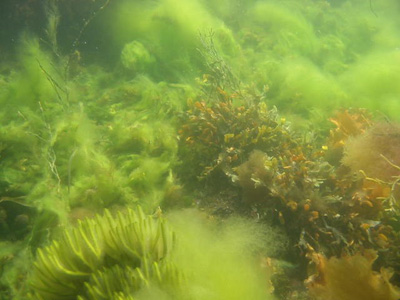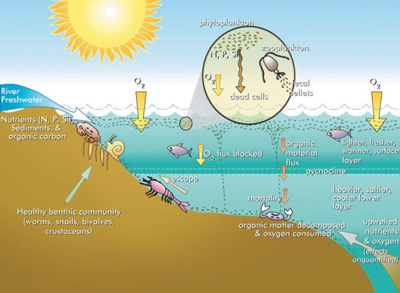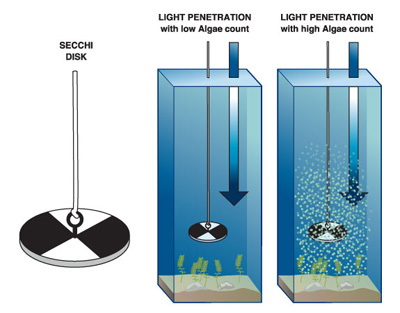3. Eutrophication & Health (2/5)
Primary and secondary effects
As we have learned in the ecology chapter Phytoplankton are at the base of the food chain in aquatic systems. They have very fast generation times, often less than a few days, and can in this way respond rapidly to changes in nutrient concentration. Their response is quantified in terms of:
- Primary production
- Biomass (chlorophyll-a concentration, or carbon biomass)
- Phytoplankton Bloom frequency
Primary production is usually limited by availability of light and nutrients. Nutrient enrichment increases phytoplankton primary production, which increases biomass even leading to algal blooms, which decreases light penetration through water column.
How can we use a simple white disc to measure light penetration?
Submerged aquatic vegetation is affected by eutrophication through:

Source: FisheryCrisis
1) Increased turbidity of the water and increased amounts of phytoplankton can reduce the light penetration and cause shadowing effects in deeper water layers. This can lead to reduced depth distribution, biomass, composition and species diversity of the vegetation;
2) Short-lived (annual) macro algae can increase rapidly with large nutrient inputs at the cost of long lived species. This can lead can lead to a change in structure of macro algal communities and reduce biodiversity.
Additionally,
- Sea grass meadows and perennial macro algae are important nursery areas for coastal fish populations.
- Many species of the short-lived macro algae can cause problems and nuisances in coastal areas when they suddenly increase rapidly.
Oxygen depletion, or hypoxia, is an effect of eutrophication in bottom waters. After a bloom of phytoplankton the plankton dies off and sinks to the bottom layers. The decomposition of these algae costs oxygen en produces carbon dioxide. If a large amount of algae dies off at once this can remove almost all the oxygen in the water from a certain area, causing problems for other species like fish, shellfish and aquatic plants. This effect may be episodic, occurring annually (most common in summer/autumn), persistent, or periodic in the coastal zone.

Source: Wikipedia
The reduction of oxygen in the water column has multiple effects:
- Lethally low oxygen concentrations depend on the species. Fish and crustaceans have higher oxygen requirements for example
- Hypoxic and anoxic (no oxygen) conditions may results in formation and release of hydrogen sulphide (H2S), which is a lethal toxin to most organisms.
- Anoxic periods cause the release of phosphorus from sediments - dissolved inorganic phosphorus (DIP), and ammonium is released under hypoxic conditions. DIP and ammonium in water column can in turn enhance algal blooms leading to even worse conditions.
- Expert predict that the effect of global warming will be an increase hypoxia as temperatures rise. Studies show that if the temperature in the atmosphere increases with 4 degrees this can result in a doubling of hypoxia in some parts of North Sea.
Invertebrate benthic fauna can cope with oxygen depletion to varying degrees (days – month). If O2 drops to zero and H2S is released all organisms are killed immediately. In less extreme cases mobile benthic invertebrates living in sediment (mostly crustaceans) move to surface when O2 decreases. Fishermen have reported increased catches of fish and crustaceans during these times.
It is difficult to predict when animals will return after an eutrophication event. The severity and the amount of mortality play an important role but also the size of the affected area: small areas are re-colonised and re-established more quickly than larger areas.

